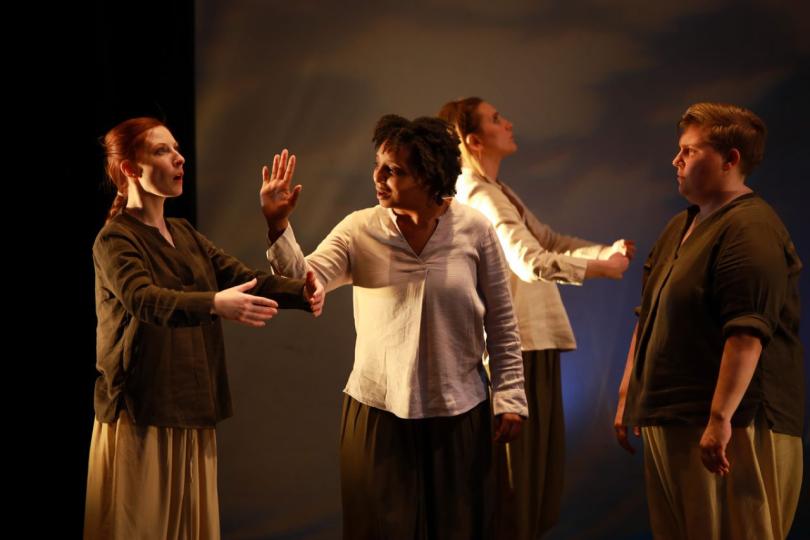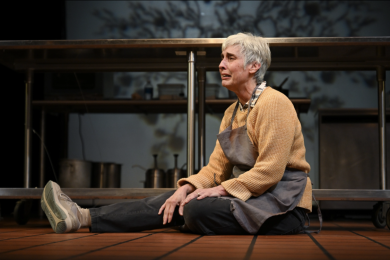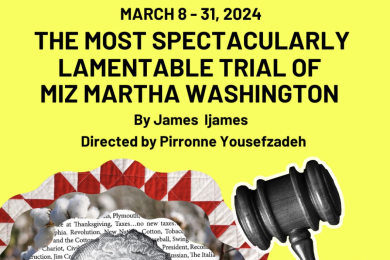Transatlantic Love Affair’s latest is “Fired Up” but needs more “Fleshing Out”

Transatlantic Love Affair is a company that “believes the human body to be the ultimate theatrical instrument.” They use voices and bodies not just to narrate but to fully articulate the world of the play. Unsurprisingly, the set for their latest production, After the Fires, is bare (with the exception of talented cellist Emily Dantuma) until the six members of the ensemble come on stage to start the action. Right away, I was confused. There were lots of flurried movements illustrating what, I can only assume based on the title, is the destruction of the world as we know it. This is the backstory? The set up? The prequel? Like a dystopian young adult novel, is this before and then during the aforementioned fires? I think I recognized flames, both in sound and flourish, but I did not get a sense of where the heck I was and what exactly was happening. When the actors start talking and interacting as characters, we jump to the present day and we learn that the population is dying off from an unknown “sickness” and they need to retrieve the “healers” of old to save them. Two young apprentices, ROBIN AND WREN, take on the daunting task of finding the healers and/or the medicine to help save their community. This seems straightforward enough.
Unfortunately the plot veers off from here. ROBIN (an always delightful Allison Witham), is in training to become the next “Keeper” of the clay pots. This job requires being in charge of the stories, which I automatically assumed were the community’s oral histories. WREN (Vinecia Coleman) is likewise the water “keepers” apprentice, equally responsible for ancient songs. There is a big emphasis on becoming these specific keepers as they carry the weight and the history of the people who are dying off, or so I thought. Once on their trip, ROBIN tells some comforting origin stories only to joke that they’re not actually true, and follows this up claiming, “stories don’t have to be true as long as they bring hope.” Similarly, WREN shares that their ancient songs are not so much songs, but music with no coherent content at all; she’s only keeping musical notes and scales alive. In the absence of more coherent world-building through the artforms we are told at the beginning that they treasure, it was very hard to understand who this community is, what has happened to them, and why I should care.
TLA lists in their mission statement and program preface the pursuit of “reimagining old stories to speak to issues of current concern.” But, it appears that this piece didn’t start with an actual scripted story and was divised in every sense of the word. Knowing this origin made the weaker plot make sense; it almost felt as though they jumped into storytelling without fully understanding the world they wanted to show. Without a more comprehensible story, it was clear the performers had trouble articulating it, especially in the non-verbal sections. As the two traveled on, there was inconsistency and varied skill level in the movement and mime on stage, and I couldn’t get my bearings. There are a lot of vocal “ffffffts” “ticks,” and “has” but I couldn’t identify what they signifed in the moment. More fire? I recognize representations of some amazing stars and deadly snakes, but I missed some important trees, kilns and fireflies, and it felt like I constantly had to play catch up. Perhaps some more time in the rehearsal room would have allowed people to solidify specific movements and get everyone on the same page and skill level. Ultimately, It never felt like the group got to the place of becoming something whole--the atmosphere they wanted to create never felt fully realized. This was particularly sad because so much of this play rests in the hands of the ensemble. They create the literal path--the set, the props, the other characters and most importantly, the central conflict.
Frankly, this all surprised me. I saw TLA’s Ballad of The Pale Fishermen, which remains one of the best things I’ve ever seen in The Twin Cities. The ensemble was impeccable at creating the world of the play and using their bodies to enhance the world, rather than distracting me from it. Unfortunately, much of this play felt like distraction, with one big exception (spoiler alert): the river scene. On the journey ROBIN and WREN come across a river and ROBIN falls in! ALL six actors/bodies/voices sync up and make this look remarkably real. Because of this, the audience can see her under the water, popping out, sputtering for breath, and going back under. THIS was gorgeous and by far the highlight of the show for me. I knew exactly what was going on and, with the help of my imagination, could put myself right in that river with her. THAT’s what I know and expect from this talented company.
“In this time when our spirits and our earth are so deeply in need of medicine, it felt appropriate to tell a story about seeking for Healers,” say director and creator, Isabel Nelson in her director’s note. The production is pretty, the costumes are clean and simple, the music (live and otherwise) compliments the action, and the lighting (designed by Barry Browning with a show dedication to the late Mike Wangen a fellow lighting designer) is nothing, if not atmospheric. Picture this: soft lights and actors' hands create a magnificent night sky, complete with noticeable constellations. Witham and Coleman are strong leads and have great mime skill. Honestly, I’d watch Allison Witham read an imaginary phone book. She is nuanced, precise, and you can see the imaginary objects she creates down to their shape and weight. It’s head shakingly impressive. The two have a friendly chemistry and you believe they have each others back; together, they overcome their fear with bravery and tenacity. They convey the absent animals and trees need to be saved, and the idea of tree sap can be the healing elixir. The show resonates with the reality of our fragile environment and highlights the importance of nature to human existence. It’s a tale of friendship, hope and yes...resilience.
I appreciate what Transatlantic Love Affair is trying to do with After the Fires, I’m just not sure it is fully realized. In its advertising they claim that the play is “Inspired by the archetypal hero’s journey, After the Fires, offers a story of wonder and resilience in times of darkness.” Although I could definitely identify the outline of a “hero's journey,” this actual story (like that explanation) is vague, and left me wondering what I missed. You have another weekend to catch this show at Illusion Theatre, Downtown, Minneapolis and see for yourself.
Editor's note: the orignal article listed Mike Wangen as the lighing designer, we have updated the article to reflect the correct lighting designer and the dedication of the performance the the late Mike Wagen.




